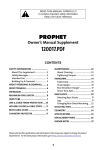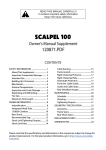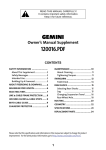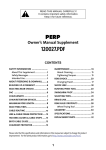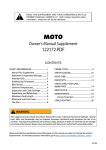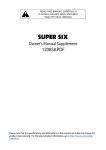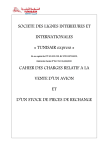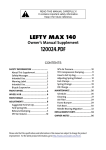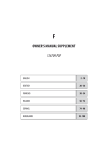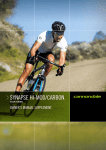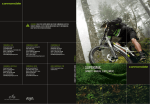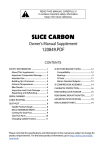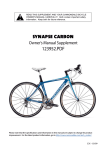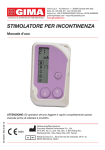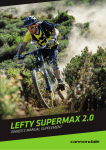Download 120018 07 RUSH.indd
Transcript
READ THIS MANUAL CAREFULLY! It contains important safety information. Keep it for future reference. rush carbon & rush Owner’s Manual Supplement 120018.PDF CONTENTS SAFETY INFORMATION ........................... About This Supplement .......................2 Safety Messages ....................................2 Important Composites Message .......3 Intended Use ..........................................3 Inspection & Crash Damage ..............4 Repainting & Refinishing ....................4 Extreme Temperatures......................... 5 Building Up A Frameset ....................... 5 Bike Stands ............................................. 5 MAXIMUM FORK LENGTH..................... 6 SI BOTTOM BRACKET SHELL ................. 12 SWINGARM...........................................14 Field Check ............................................ 14 Chainstay Bridge ................................. 16 Rear Derailluer Hanger .......................17 Chainslapper ........................................ 18 SELECTING TIRES ...................................19 REAR SHOCK ........................................ 20 Selecting Rear Shocks ........................ 21 Sag .................................................... 21 MAINTENANCE .................................... 22 About Cleaning ....................................23 Tightening Torques .............................23 GEOMETRY ............................................25 RUSH HEAD TUBE .................................. 7 RUSH CARBON HEAD TUBE ................... 7 RUSH CARBON MINIMUM SEAT POST INSERTION DEPTH ............... 8 SPECIFICATIONS ................................... 26 LINE & CABLE FRAME PROTECTION ...... 9 REPLACEMENT PARTS ...........................27 HOUSING GUIDES & CABLE STOPS ......10 OWNER NOTES .................................... 28 RIGHT CHAINSTAY PROTECTOR ............ 11 Please note that the specifications and information in this manual are subject to change for product improvement. For the latest product information, go to http://www.cannondale.com/tech/. 1 about this supplement safety messages Cannondale Owner’s Manual Supplements provide important model specific safety, maintenance, and technical information. They are not replacements for your Cannondale Bicycle Owner’s Manual. In this manual, information which affects your safety is emphasized in the following ways: WARNING This supplement may be one of several for your bike. Be sure to obtain and read all of them. If you need a manual or supplement, or have a question about your bike, please contact your Cannondale Dealer immediately, or call us at one of the telephone numbers listed on the back cover of this manual. You can download Adobe Acrobat PDF versions of any Cannondale Owner’s Manuals or Supplements from our website: http://www.cannondale.com/bikes/tech. • This manual is not a comprehensive safety or service manual for your bike. • This manual does not include assembly instructions for your bike. • All Cannondale bikes must be completely assembled and inspected for proper operation by a Cannondale Dealer before delivery to the owner. A WARNING indicates a potentially hazardous situation which, if not avoided, can result in serious injury or death. CAUTION A CAUTION Indicates a potentially hazardous situation which, if not avoided, can result in serious damage to the product. The matters described under CAUTION may, if not avoided, lead to personal injury, or results depending on the situation and degree of damage. Important matters are described in CAUTION (as well as WARNING), so be sure to observe them. A NOTE provides helpful information or tips intended to make the information presented clearer. WARNING This document may include procedures beyond the scope of general mechanical aptitude. Special tools, skills, and knowledge may be required. Improper mechanical work increases the risk of an accident. Any bicycle accident has risk of serious injury, paralysis or death. To minimize risk we strongly recommend that owners always have mechanical work done by an authorized Cannondale retailer. 2 120018.PDF important composites message intended use (RUSH CARBON) Cross-Country, Marathon INTENDED for cross-country riding and racing which ranges from mild to agressive over intermediate terrain (e.g., hilly with small obstacles like roots, rocks, loose surfaces and hard pack and depressions). There are no large “sick drop” or drop offs, jumps or launches (wooden structures, dirt embankments) requiring long suspension travel or heavy duty components. Cross-country and marathon equipment (tires, shocks, frames, drive trains) are light-weight, favoring nimble speed over brute force. Suspension travel is relatively short since the bike is intended to move quickly on the ground and not spend time in the air landing hard and hammering through things. Your bike is made from composite materials also known as “carbon fiber.”. All riders must understand a fundamental reality of composites. Composite materials constructed of carbon fibers are strong and light, but when crashed or overloaded, carbon fibers do not bend, they break. For your safety, as you own and use the bike, you must follow proper service, maintenance, and inspection of all the composites (frame, stem, fork, handlebar, seat post, etc.) Ask your Cannondale Dealer for help. We urge you to read PART II, Section D. “Inspect For Safety” in your Cannondale Bicycle Owner’s Manual BEFORE you ride. NOT INTENDED for use in extreme forms of jumping/riding such as hardcore mountain, Freeriding, Downhill, North Shore, Dirt Jumping, Hucking etc. WARNING YOU CAN BE SEVERELY INJURED, PARALYZED OR KILLED IN AN ACCIDENT IF YOU IGNORE THIS MESSAGE. TRADE OFF Cross-Country bikes are lighter, faster to ride uphill, and more nimble than All-Mountain bikes. CrossCountry and Marathon bikes trade off some ruggedness for pedaling efficiency and uphill speed. WARNING USING YOUR BICYCLE IMPROPERLY IS HAZARDOUS. 3 repainting or refinishing inspection & crash damage (RUSH CARBON) (RUSH CARBON) You should not paint over the existing finish, refinish or repaint your bike. The carbon fiber composites making up the frame are held together by some extremely strong bonding chemicals. However, these bonds can be attacked or weakened by paint stripping or refinishing chemicals. WARNING AFTER A CRASH OR IMPACT: Inspect frame carefully for damage (See PART II, Section D. Inspect For Safety in your Cannondale Bicycle Owner’s Manual.) WARNING Do not ride your bike if you see any sign of damage, such as broken, splintered, or delaminated carbon fiber. Repainting, painting over, retouching, or refinishing your frame or fork can result in severe damage leading to an accident. You can be severely injured, paralyzed or killed. ANY OF THE FOLLOWING MAY INDICATE A DELAMINATION OR DAMAGE: An unusual or strange feel to the frame Refinishing chemicals : Solvents, and strippers can attack, weaken, or destroy the important composite chemical bonds holding your frame together. Carbon which has a soft feel or altered shape Creaking or other unexplained noises, Visible cracks, a white or milky color present in carbon fiber section Using abrasives or sanding the frame/ fork structure, original paint, decals, or coatings through the use of mechanical actions such as plastic or glass bead blasting or other abrasive methods such as sanding or scraping can remove frame material or weaken it. Continuing to ride a damaged frame increases the chances of frame failure, with the possibility of injury or death of the rider. 4 120018.PDF protect from extreme temperatures • Protect your bike from extreme temperatures when storing or transporting it. • Allow your bike to cool off or warm up before you ride • Do not store your bike in places where the temperature will exceed 66.5C° (150°F). bike stands The clamping jaws of an ordinary bike stand can generate a crushing force strong enough to seriously damage and ruin your bike frame. CAUTION Never place your bike in a bike stand by clamping the frame. Place your bike in a stand by extending the seat post and positioning the stand clamp on the extended seat post. Don’t extend beyond the MINIMUM INSERT line marked on the seat post. For example, do not leave your bike lying flat in a black pickup truck bed in the desert sun, 0r, under Since your carbon seat post can also be damaged by clamping force, adjust the stand clamp for the minimum clamping force needed to secure the bike. the glass of a hatchback auto. building up a frameset Before building up a frameset, consult with your Cannondale Dealer and the component manufacturers, and discuss your riding style, ability, weight, and interest in and patience for maintenance. Make sure the components chosen are compatible with your bike and intended for your weight and riding style. seat post minimum insertion depth (RUSH CARBON) See page 8. Generally speaking, lighter weight components have shorter lives. In selecting lightweight components, you are making a trade-off, favoring the higher performance that comes with less weight over longevity. If you choose more lightweight components, you must inspect them more frequently. If you are a heavier rider or have a rough, abusive or “go for it” riding style, buy heavy duty components. Read and follow the component manufacturers warnings and instructions. 5 maximum fork length Maximum Fork Length is an important frame safety testing specification. You must observe the measurement when installing headset parts, headset adapters, installing and adjusting a fork, and replacement forks. The specification is printed on a warning label indicated in the figure below. In this manual, the number is also listed in the specifications section. HOW TO MEASURE: HEADTUBE HEADSET PARTS or ADAPTERS WARNING MAXIMUM FORK LENGTH 500 mm MAXIMUM FORK LENGTH See Owner’s Manual Supplement. 1. Temporarily install the fork into the headtube with the headset/ adapter in use. 2. Fully extend the fork. If the fork is a triple clamp type, extend the legs to maximum designed length. 3. Measure the distance from the bottom of the head tube to the center of the wheel axle. Do not measure from the bottom of headset bearing cups or head tube adapters. The measurement MUST be taken from the bottom of the head tube!! The Maximum Fork Length in millimeters will be printed on the label. WARNING DO NOT INSTALL HEADSET PARTS OR FORKS RESULTING IN A MAXIMUM FORK LENGTH LONGER THAN THE SPECIFICATION FOR YOUR FRAME. DO NOT ADJUST A TRIPLE CLAMP FORK SO THAT MAXIMUM FORK LENGTH EXCEEDS THE FRAME LIMIT. Exceeding the MAXIMUM FORK LENGTH limit can overload the frame causing it to fail (break) while riding. YOU CAN BE SEVERELY INJURED, PARALYZED OR KILLED IN AN ACCIDENT IF YOU IGNORE THIS WARNING. 6 120018.PDF rush head tube The alloy RUSH head tube accepts both Cannondale HeadShok System Integration™ headsets (shown), and OnePointFive 1.5 (38.1mm) headsets. rush carbon head tube The carbon RUSH head tube cups accepts only Cannondale Headshok System Integration cartridge bearings. SI SEAL SI CARBON SEAL SI BEARING SI BEARING SI CUP SI CUP SI BEARING SI BEARING CAUTION CANNONDALE KIT # KIT Includes QHDST/EBO/ 2 - SI Alloy Headtube Bearing Cups and 1 SI Headset Bearing. HD169/ 2 SI Headset Bearings QSMSEAL/ 1 Upper Bearing Seal for RUSH QSCSEAL/ 1 Upper Bearing Seal for RUSH CARBON The headtube bearing cups are permanently bonded in place. Do not attempt to remove. Do not face, surface, or cut the cups. 7 seat post minimum insertion depth (RUSH CARBON) For RUSH CARBON bicycles, you must insert the seat post so that a length extends into the seat tube 100mm, 4 inches; this is called the MINIMUM SEAT POST INSERTION DEPTH. See the illustration below. SEAT POST SEAT TUBE MINIMUM SEAT POST INSERTION DEPTH 100mm, 4 inches WARNING MAKE SURE THE SEAT POST IS INSERTED TO THE CORRECT DEPTH FOR THE FRAME. You must measure this depth on the seat post with a tape measure. Remove the seat post, measure and make a mark on the seat post at 100mm, 4 inches. Use a permanent marker or other non-damaging method to indicate. Never adjust the seat post so that the line you make is above the top edge of the seat tube. YOU MUST ALSO BE AWARE THAT bicycle seat posts are permanently marked by the manufacturer with a “MINIMUM INSERT” line on the seat post itself. You must not rely on this marking as an indication of the proper MINIMUM SEAT POST INSERTION DEPTH for your RUSH CARBON. 8 120018.PDF line and cable frame protection Normal line and cable movement against the frame can wear away painted finishes and decals. Overtime, cable rubbing can wear into the frame itself causing very serious frame damage. Check over your bike after your first few rides. Apply a clear adhesive guard material in areas where rubbing is found. PLEASE NOTE: Damage to your bike caused by cable rubbing is not a condition covered under your warranty. Also, adhesive frame guards are not a fix for incorrectly installed or routed cables or lines. If you find that applied guards are wearing out very quickly, consult with your Cannondale Dealer about the routing on your bike. When applied correctly, clear guards are good protection for your bike. Cannondale Kit # KF103/ (8 PK) To apply the guard material (included with your bike): 1. Clean the frame with a mild detergent and wipe dry with a clean towel. Do not use solvents or harsh chemicals to clean the frame. OPTIONAL: Trim the adhesive guard material to the shape required. 2. Remove the backing and position the guard under the cable/ line. 3. Rub the guard firmly against the frame with your fingers to fix it in place. 4. Periodically, recheck the guards and other areas of the frame as you continue to ride. Replace the guards if they wear out. PHOTO ABOVE SHOWS A TYPICAL LOCATION FOR THE GUARD. IN THIS CASE, ITS THE AREA IN FRONT OF THE SWINGARM ON THE DOWNTUBE. 9 housing guides and cable stops bottom bracket front derailleur cable guide Lines and cables on your bike are routed through frame guides using cable stops (1) and /or cable thru guides (2). This snap in front derailleur cable guide is mounted on the lower bottom bracket shell. Periodically, you should check to make sure the stops and guides are in good condition and seated properly in the frame guides. For stops, make sure the stop is seated securely in the frame guide and the housing is fixed within the stop. Cannondale Kit # KF014/ (2 PK) chainstay protector An adhesive chainstay protector is located on the underside of the right chainstay. This guard protects the chainstay from damage caused by the chain. Check the condition of the right chainstay protector periodically and replace it when it is worn or missing. 1 Cannondale Kit # KF086/ (10 PK) Cannondale Kit # KF085/ (a) 2 Cannondale Kit # KF078/ 10 120018.PDF 3 4 1 2 1. Chainstays - The custom hydroformed and tapered chainstays are optomized for lateral and torsional siffness, 3D bent for vertical compliance and explosive sprints. 2. Internal Rear Derailluer Cable Guide Routing - The chainstays feature an internal routing path for the rear derailleur giving the Rush a clean look with less cable movement and no ghost shifting. 3. Seatstays - The domed and butted seat stays provide superior strength and boost the torsional stiffness where they meet the swingarm pivot 4. Hot Box - The Hot Box’s forged and CNC’d hollow core boasts a tremendous stiffnessto-weight ration, providing the same stiffness as the solid core pivot with the incredible weight savings of a hollow core. 11 si bottom bracket shell Bearings The two bearings in the SI bottom bracket shell are a maintenace free sealed cartridge type and do not require lubrication. The bearings can be worn out overtime or damaged due to corrosion. The condition of the bearings should be inspected annually or anytime the crankset assembly is disassembled or serviced. Please consult the SI Cranksets Owner’s Manual Supplement for specific information on servcing the SI crankset on your bike. It is available on our website: http://www.cannondale.com/tech/ Cannondale special tool KT011/ is needed to remove the bearings. Replace bearings as a new set. Do not reinstall removed bearings. Cannondale special tool KT010/, a press set for use with headset bearing press, is needed to install the bearings. The two circlips must be installed before the bearings. It is not necessary to remove the circlips to service the bearings. Replacements are available if they become damaged. They can be lifted from the BB groove by lift the hooked end with a thin blade screwdriver. SI-to-Standard BB Adapter The SI bottom bracket adapter enables the use of standard English/68mm bottom bracket cranksets. The adapter IS NOT a repair part and will only work in undamaged frames in good condition. Improper installation or removal can result in damage and void applicable frame warranty. Cannondale Kit # Description KF365/ 68mm Shell Width - This kit includes the SI bottom bracket adapter and tools for use with a standard bicycle headset bearing press. KF368/ 73mm Shell Width - This kit includes the SI bottom bracket adapter and tools for use with a standard bicycle headset bearing press. KF366/ This kit includes a two-piece adapter extraction tool for use with a standard bicycle headset bearing press. WARNING CARBON RUSH STANDARD BOTTOM BRACKET SHELL THREADED INSERT (1) IS PERMANENT AND NON-REMOVABLE. DO NOT ATTEMPT TO REMOVE IT. YOU CAN CAUSE SERIOUS FRAME DAMAGE. Once installed, the adapter is a nonremovable/ permanent frame part. 12 1 120018.PDF KT011/ KB6180/ KT010/ te ) cti en Lo (gre 9 60 VE OO R G KF366/ KF365/ or KF368/ Drive Side BB The GROOVE of the ADAPTER goes on the drive side. VE OO R G Thin-blade screwdriver to lift out circlips.. QC616/ 13 Pivot Axle & Pivot Nut swingarm The pivot axle, bearings, and bearing shields are subject to wear depending on use, conditions, and maintenance. Periodic disassembly, cleaning, and regreasing will extend time between necessary renewal. field check 1. Place the bike in a work stand and remove the rear wheel. 2. Remove the rear shock. 3. Stand behind the bike holding the swingarm by the dropouts. The pivot must always be installed with the head on the drive side (right) of the frame. The pivot can not be removed without removing the crankset. When the pivot nut is removed the pivot will slide out easily. However, before it is removed the weight of the swingarm should be supported to prevent it dropping suddenly causing injury or damage. Bearings The swingarm pivot bearings are a sealed cartridge type and do not require lubrication. Lift it up and down. The pivot should move smoothly without sticking allowing the swingarm to fall under its own weight. Be careful, don’t let the swingarm slam against the frame. Next, still holding the dropouts, try to detect any excessive play side-toside. Excessive side-to-side play can be caused by a loose pivot nut or damage to the bearings or other pivot parts. If you find the swingarm movement rough or gritty or detect excessive side-to-side play, the pivot assembly should be inspected. An inspection will require, disassembly, cleaning and parts inspection. Replacement of worn part may be necessary. Have this service performed by your Cannondale dealer. 14 A film of grease applied to the faces of the bearing can be applied to help to repel damaging moisture. To check the bearings: With the pivot out, rotate the inner bearing race with your finger tip to confirm smooth rotation. Replace bearings if the rotation feels rough or gritty. When necessary, replace bearings as a new set. Drive out the old bearings carefully and install new ones using proper bearing installation tools. Spacers The spacers are located between the bearings and frame. The smooth rounded side of the spacer faces the frame while the flatter side of the spacer fits against the bearing. To check the spacers, remove them and look for any uncharateristic wear, deep grooves, cracks or other damage. Be sure to check the frame bore surfaces as well. A rough surface can accelerate wear. If the spacers are in good shape, clean and regrease them before reinstallation. Make sure they go back in the right way. See the next figure. 120018.PDF 242 GREASE 2 1 m 8m key n Alle GREASE 4 19 mm 12 N•m (106 In•Lbs) 3 Cannondale Kit # KF100/ includes (1), 2X (3), and (4) Cannondale Kit # KB61902/ includes 1X(2) CROSS SECTION 3 3 2 2 FRAME BORE 1 A B 4 A 1. Pivot Axle A - Rounded side of spacer faces frame 2. Bearings B - Flat side of spacers fits into bearing B 3. Spacers 4. Pivot Nut CAUTION • Remove the rear wheel before servicing the pivot assembly. Support the swingarm from dropping or falling to prevent damage to the seat tube. • Remove chainstay bridge if applicable. See next page. • Clean the pivot axle and frame bore. Apply a light film of bicycle bearing grease to both grease before reassembly. Too much grease will collect damaging grit. 15 CHAINSTAY BRIDGE BOLTS Loctite 242 5 N•m Replacement bridge and bolts Cannondale Kit # KF369/ swingarm chainstay bridge This part, available on selected models, must be removed from the swingarm in order to remove the swingarm from the frame. Remove the four bolts securing this plate and remove the plate BEFORE removing the swingarm pivot assembly. When reinstalling the swingarm, install the pivot assembly first, then install the chainstay bridge. Following the Loctite and tightening torque indicated above. The chainstay bridge is REQUIRED 16 120018.PDF rear derailleur hanger replacement When installing replacements, be sure to throughly clean and inspect the dropout for any damage. Do not install a replacement hanger onto a damaged dropout. GROMMET Cannondale Kit # KF102/ (10pk) 5 mm Allen key Loctite 242 5 N•m (44 In•Lbs) GREASE MATING SURFACES Cannondale Kit # KF051/ Before re- installing (same or new): Clean surfaces and apply a light film of bike grease between the hanger and dropout to minimize any noise or “creaking” that might result from very slight movement between the dropout and hanger during movement of the derailleur. Apply Loctite and tighten the hanger nut/bolt to the specified torque. Be sure to check alignment of derailleur hanger following remounting. Be sure to readjust wheel quick release so it is very tight. 17 Replacement chainslapper Cannondale Kit # 7A510/BLK chainslapper The chainslapper is a replacable protection for the swingarm. It can be installed over and in addition to the clear chainstay protector (See page 11). Install t as shown in photo above. Make sure you press the hook and look sections togther and press firmly along the entire length for a secure fit. If the chainslapper ever becomes loose or damage, replace it with a new one. 18 120018.PDF selecting tires Any properly installed and inflated tire must not contact any part of the swingarm, frame, or fork and throughout full suspension travel. The U.S. Consumer Product Safety Commission (CPSC) requires at least 1/16” (1.6 mm) tire clearance from any part of the bike. Allowing for lateral rim flex and a wheel or rim that is out-of-true will likely mean choosing a rear tire that provides even more clearance than the CPSC recommends. Also, your choice of replacement tires should be made only after considering the clearance guidelines contained in suspension product owner’s manual. If the manufacturer’s manual contains no such guidelines, or if you don’t have a manual, consider that Rock Shox requires at least 1/4” (5 mm) clearance between the tire and the fork crown or bridge when the fork is completely compressed. Be aware that completely compressing the fork may involve removing the spring stack, letting the air out of the fork, or both. WARNING SELECT PROPERLY SIZED/ FITTED TIRES FOR YOUR BIKE. Mounting the wrong size tires on your bike can increase the chances that you will have an accident where you can be severely injured, paralyzed, or killed. If the tires touch the frame or fork when riding, you can lose control of your bike. If a moving tire is stopped because it touches the frame or fork, you can be thrown off the bike. You can be severely injured or killed. Do not mount oversized tires, ones that rub or touch the frame, ones that result in too little clearance with the frame, or ones that can touch the frame or fork when the suspension is fully compressed or when riding. Take care that the tires you select are compatible with your bike’s frame design. Also, be sure to follow the manufacturer’s recommendations of your front fork and rear shocks. Ask your Cannondale Dealer for the right tires for your bike and its particular components! 19 rear shock Replacement bolt set Cannondale Kit # KF110/ 5 N•m 37.5mm RUSH = 32.5mm RUSH CARBON = 28.8mm 5 N•m WARNING KEEP YOUR HANDS AND FINGERS OUT OF PINCH POINTS. Your fingers or hands can be pinched or crushed if they are caught between the swingarm, linkage, tire, or frame when the rear shock is released. CAUTION TO PREVENT SERIOUS FRAME DAMAGE: 1. Make sure the rear shock is compatible with your frame. Ensure that the shock eyelet-to-eyelet length stroke length match the information in the specifications section of this manual. 2. Make sure the physical shape of the rear shock (including all reservoir and adjustments features) will not cause interference with or contact the frame, frame mounting points, or the swingarm at any point in the full suspension travel. See our website TECH CENTER (http://www.cannondale.com/bikes/tech/) for more on how to mount the OEM shocks for your bike. 3. Do not alter or modify the frame/swingarm in an attempt to mount a rear shock. 20 120018.PDF selecting rear shocks WARNING SELECT ONLY COMPATIBLE SHOCKS AND FORKS FOR YOUR BIKE. DO NOT MODIFY YOUR BIKE IN ANY WAY TO MOUNT ONE. HAVE YOUR SHOCK OR FORK INSTALLED BY A PROFESSIONAL BIKE MECHANIC • Riding with the wrong rear shock can damage the frame. You could have a serious accident. Make sure the total travel, eye-to-eye length, and stroke length of the rear shock you select meet the specifications listed in this manual. • When selecting different shocks or forks for your bike, make sure that the shock or fork you select is compatible with your bike’s design and how you will use your bike. sag Sag is the distance the bike suspension compresses with a rider (wearing all appropriate gear) mounted in a normal riding position (seated, hands on handlebar and feet on the pedals) on flat ground. The recommended sag for your bike is intended to maximize the bike’s suspension travel and it is usually specified as a percentage (%) of the fork or shock’s total travel. Maintaining the recommended sag in both the front and rear suspension helps assure that the fork and shock operate normally without excessive top-out or bottom-out that can lead to difficult handling or damage. CAUTION Please read the fork and rear shock manufacturer’s owner’s manual and instructions provided before attempting any set-up or adjustment. Small adjustments to sag are performed by adjusting preload of the shock or fork. With coil springs this is done by adding or removing spring shims, adjusting the installed length of the spring with a preload adjusting ring. With air springs, changing air pressure changes preload Larger adjustments to sag may require changing the installed springs in the fork or shock. Changing the spring may be a simple task or very complex depending on the design of the fork or shock. In general: increasing preload decreases sag, decreasing preload increases sag. Finding tuning sag within the suspension fork or rear shock range is a matter of personal preference taking body weight and how you ride into consideration. 21 maintenance The following table includes supplemental maintenance items for your bike. Please consult your Cannondale Bicycle Owner’s Manual for more information on basic bike maintenance. And, so you may create a complete maintenance program best suited to you and your riding style, please talk to your Cannondale Dealer. Also, remember to follow the maintenance recommendations given by the component manufacturers for the various non-Cannondale parts of your bike. Schedule HOW OFTEN You/ Professional Check lines/ cables for rubbing, install guard material. Before and After 1st Rides YOU Clean and visually inspect entire bike frame/ swingarm for cracks or damage Before and After Each Ride YOU Every 25 hours YOU or Professional As needed YOU Every 10 hours YOU Every 10 hours YOU WHAT TO DO SWINGARM PIVOT ASSEMBLY: FIELD CHECK (Disassemble, Clean, Inspect, Re-grease As Needed) See page 16. SWINGARM CHAINSTAY PROTECTOR: Replace if necessary Check condition/ attachment of cable stops and housing guides. TIGHTENING TORQUES In addition to other component specific tightening torques for your bike, check the tightness of the items listed in “Tightening Torques” in this manual. WARNING ANY PART OF A POORLY MAINTAINED BIKE CAN BREAK OR MALFUNCTION. AND, THAT CAN LEAD TO AN ACCIDENT WHERE YOU CAN BE KILLED, SEVERELY INJURED OR PARALYZED. Please ask your Cannondale Dealer to help you develop a complete maintenance program, a program which includes a list of the parts on your bike for YOU to check regularly. Frequent checks are necessary to identify the problems that can lead to an accident. 22 120018.PDF About Cleaning When cleaning your bike: USE ONLY A MILD SOAP AND WATER SOLUTION. Clean water and a common dish washing liquid will work best. COVER SENSITIVE AREAS WITH A CLEAN PLASTIC BAG. Secured temporarily with a rubber band or masking tape, a bag can prevent water damage to various bike components (bearings, seals, fork / shock adjustment features). SPRAY OFF BEFORE WIPING. To preserve the appearance of paint, finish, and decals, use a low pressure water hose to first spray off heavy soils and dirt. CAUTION DO NOT power wash or spray water under high pressure to clean. Power washing will force contaminants into parts where they will promote corrosion, immediately damage, or result in accelerated wear. DO NOT use compressed air to dry. DO NOT use abrasive or harsh chemical cleaner/solvents which can damage the finish or attack and destroy both the outside and internal parts. When rinsing, avoid directing the spray directly at shock/fork adjusters or bearings. Tightening Torques Component-specific values (for crank bolts, rotor bolts, do not appear below because they will vary based on the spec-level of the bike; please consult the manufacturer of the component in question for the correct torque value. Item Loctite # N•m In•Lbs Shock Mounting Bolts 242 5 44 Chainstay Bridge Bolts 242 5 44 Swingarm Pivot Nut 242 12 106 Rear Derailleur Hanger Mounting Bolt 242 5 44 23 geometry C CARBON STL J A K B E L G H F I RUSH CARBON Rush 3, Rush 3Z, Rush 4, Rush 5, Rush 6 SIZE SMALL MEDIUM STL Seat Tube Length (cm/in) 40.5/15.9 43.0/16.9 A Seat Tube Angle (degree) 73.5 ★ B Head Tube Angle (degree) 69.0 ★ C Top Tube Horizontal (cm/in) 52.3/20.6 56.2/22.1 E Chainstay Length (cm/in) 42.2/16.6 ★ F Fork Rake (cm/in) 4.5/1.8 ★ Bottom Bracket Height G 32.0/12.6 ★ (cm/in) H Wheel Base (cm/in) 106.0/41.7 110.2/43.4 I Fork Trail (cm/in) 7.9/3.1 ★ Standover Top Tube Midpoint J 74.9/29.5 75.2/29.6 (in/cm) K Bottom Bracket Drop (cm/in) 1.0/0.4 ★ L Front Center Distance (cm/in) 63.9/25.1 68.1/26.8 Rear Travel (in/cm) 4.70/12.0 ★ Shock Eye-to-Eye (in/cm) 7.5/19.0 ★ Shock Stroke (in/cm) 1.75/4.45 ★ Recommended Sag 25% ★ All dimensions are given with suspension fully extended. ★ = same spec 24 LARGE 48.0/18.9 ★ ★ 59.4/23.4 ★ ★ X-LARGE 50.0/19.7 ★ ★ 62.3/24.5 ★ ★ ★ ★ 113.1/44.5 ★ 115.8/45.6 ★ 74.5/29.3 74.4/29.3 ★ 71.0/27.9 ★ ★ ★ ★ ★ 73.7/29.0 ★ ★ ★ ★ 120018.PDF C ALLOY STL J A K B E L G H RUSH ALLOY SIZE STL A B C E F G H I J K L F I RUSH FÉMININE Rush 3, Rush 3Z, Rush 4, Rush 5, Rush 6 Rush Féminine SMALL MEDIUM LARGE X-LARGE PETITE SMALL MEDIUM 40.5/15.9 43.0/16.9 48.0/18.9 50.0/19.7 40.5/15.9 ★ ★ 73.5 73.5 ★ ★ ★ ★ ★ 69.0 69.0 ★ ★ ★ ★ ★ 57.5/22.6 60/23.6 62.5/24.6 65.0/25.6 54.5/21.5 57.55/22.6 58.7/23.1 42.15/16.6 42.2/16.6 ★ ★ ★ ★ ★ 4.6/1.8 4.6/1.8 ★ ★ ★ ★ ★ 32.0/12.6 32.0/12.6 ★ ★ ★ ★ ★ 107.5/42.3 110.2/43.4 113.1/44.5 115.8/45.6 104.5/41.1 107.5/42.3 108.8/42.8 7.9/3.1 4.5/1.8 ★ ★ ★ ★ ★ 29.7/75.4 29.6/75.2 29.3/74.5 29.3/74.5 74.6/29.4 75.4/29.7 75.4/29.7 1.0/0.39 1.0/0.39 ★ ★ ★ ★ ★ 63.5/25 67.1/26.4 70.4/27.7 72.6/28.6 63.5/25 63.5/25 66.6/26.2 4.70/12.0 4.70/12.0 ★ ★ ★ ★ ★ 7.5/19.0 7.5/19.0 ★ ★ ★ ★ ★ 1.75/4.45 1.75/4.45 ★ ★ ★ ★ ★ 25% 25% ★ ★ ★ ★ ★ All dimensions are given with suspension fully extended. ★ = same spec 25 specifications ITEM Frame Material RUSH RUSH CARBON 6061-T6, Tig Welded, Carbon Fiber Composite Aluminum Alloy Maximum Tire Width Head Tube 2.3” Headshok, Onepointfive Headshok Maximum Fork Length 500mm Seat Post Diameter 27.2 ±0.1 Mm Rear Shock Bushing Width (Frame Mount) 32.4 ±0.1 mm 28.8 ±0.1mm Rear Shock Bushing Width (Swingarm) 37.4 ±0.1 mm 37.4 ±0.1 mm Bolt Diameter 8.1 ±0.5 Mm Rear Shock Eyelet-to-eyelet Length 190 Mm (7.5”) Rear Wheel Travel 110 Mm Rear Shock Stroke Length 45mm Rear Shock Leverage Ratio 3:1 Regressive Front Derailleur Bottom Pull Top Swing 31.8mm Bottom Bracket Shell (Width, Thread Type) 73mm, English / SI Hollowgram 68mm, English Chain Line 47.5 Mm Dropout Spacing 135 Mm Rear Hub Spacing 135 Mm Rear Axle Quick Release Rear Brake Mount International Standard, 6” Recommended Sag 25-30% 26 120018.PDF replacement parts (kits) ORDER KIT DESCRIPTION KF100/ Kit,pivot Swingarm, Prpht/Rush KF110/ Kit,hware,shock Mounting,Rush KF102/ Kit, Guide, Grommet,-10 Pack KF103/ Kit, Guard, Scuffguard-8pk KF051/ Kit, Der Hanger; Single Sided 2 KB61902/ Kit, Bearing-61902 - QHDST/EBO Kit, Headset, 2 Cups + 1 Bearing KF014/ Kit, Cable Stop Inserts-2 KF086/ Kit, Guides, Hydr.brake.,10pcs KF085/ Kit, Guides, BB Cable,single KF078/ Kit, Guard, Chainstay, Clear Protective KF012/ Kit, Rivnuts, Bag Of 5 QC841/BBQ Kit, Seatbinder, MTN, 31.8, blk QSMSEAL/ Kit,Seal, Upper Bearing QSCSEAL/ Kit,Seal, Upper Bearing Carbon KF368/ Kit, Adapter, SIBB 73mm KF369/ Kit, Chainstay Bridge,Rush KF370/ Kit, Shock, Fox RP23, RUSH KF371/ Kit, Shock, Fox RP23,RUSH CARBON 7A510/BLK Kit, Chainslapper For an up to date list of kits available for your bike, please visit our Tech Center at : http://www.cannondale.com/tech/ 27 owner notes Record maintenance history, service, or set up information . DATE WORK PERFORMED 28




























